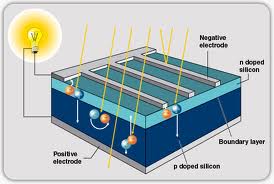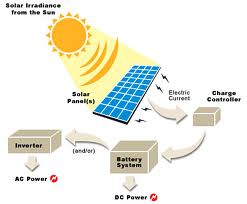Introduction:
The heart of the solar PV system is the solar panel and in Bangladesh the solar panels for PV applications are imported from other countries. However conventional storage batteries for SHSs are produced by local manufacturers. But for large PV application like the centralized system, storage batteries and inverters are imported from foreign countries. Most of the CCUs for SHS applications are locally produced and few of them are imported from outside Bangladesh. Different government, non-government organizations and educational institutions are engaged in dissemination of PV technology in Bangladesh. In this section some of them who plays major role in dissemination of PV technology in Bangladesh will be discussed.
Grameen Shakti:
Grameen Shakti is one of the pioneer private organizations in the renewable energy sector in Bangladesh. It was established in 1996 and the main motto of it is to promote, popularize and disseminate renewable energy technology at an affordable price to the rural area of Bangladesh. In order to promote renewable energy in rural areas, the Grameen Shakti has set up unit offices in different parts of Bangladesh and so far it has 189 unit offices50. Till May, 2006 it has installed 65000 SHS with approximately 4, 00,000 beneficiaries and so far covered 20,000 villages and 11 remote islands in Bangladesh (ibid). Since SHS is comparatively expensive technology therefore Grameen Shakti has introduced soft loan credit facilities for rural consumers.
Infrastructure Development Company Limited (IDCOL):
IDCOL is a non bank financial institution which was incorporated as a public limited company on 14th May, 1997 with the assistance from the World Bank under Private Sector Infrastructure Development Project. The primary objective of the company is to promote the significant participation of the private sector in investment and operation, ownership and maintenance of new infrastructure facilities. IDCOL has access to resources provided by the WB, GTZ, KfW, SNV-Netherlands Development and the Government of Bangladesh (ibid). It promotes renewable energy programs through 15 partner organizations (PO) and moreover provides technical, logistic, promotional and training assistance to the POs. These POs are private organizations who are engaged in dissemination of solar technology in Bangladesh. It supports the rural electrification by means of SHS under the Rural Electrification and Renewable Energy Development Project (REREDP) (ibid). The REREDP is jointly financed by the IDA, GEF and KfW and it has set a target of financing installation of 200,000 SHSs by 2009 (ibid). The SHSs are sold (mostly through micro-credit) by POs to the households and business entities in the remote and rural areas of Bangladesh (ibid). The IDCOL provides refinancing facility to the POs and channel grants to reduce the SHSs costs (ibid). For installation of SHS, it promotes standard technical specifications and approved equipment list for POs.
Rahim Afrooz:
Rahim Afrooz solar is a sister organization of Rahim Afrooz group. It engages in projects related to SHS installations and centralized PV system in Bangladesh. It provides equipments related to PV system to different organizations in Bangladesh. Though it imports solar panels from foreign countries but the RahimAfrooz battery, another sister organization manufactures batteries for solar PV application and other purposes. It acted as a local agent for installation of the centralized PV projects of the BPDB and LGED. It is so far the largest deep cycle battery provider for SHS in Bangladesh. It contributes in dissemination of SHS in partnership with local NGOs. Recently the Rahim Afroz Battery has introduced the battery recycling unit along with its battery manufacturing plant. Therefore the batteries of the SHS installations can be recycled after lifetime and this is the first battery recycling unit in Bangladesh.
Bangladesh Advancement Committee (BRAC):
BRAC is one of the pioneer organizations in dissemination of PV technology in Bangladesh. It was established in 1972 and it launched solar energy program for sustainable development in December, 1997. Until June 2004, the BRAC has installed SHSs of total 263.545 kWp capacities. The future goals of the BRAC are to increase the number of SHS installations, implement solar energy complex and solar energy institute.
Rural Electrification Board (REB):
The Rural Electrification Board has started its operation with the vision of rural electrification in 1978. It has successfully implemented the rural electrification program in Bangladesh through consumer cooperative society called Palli Bidut Samati (PBS). Due to the initiatives of REB along with the assistance from BPDB, people in the rural areas can enjoy the facilities of electricity now. However in order to provide electricity to remote villages, islands, coastal areas, hilly terrains and other inaccessible parts of the country, REB has executed decentralized mode of power distribution like standalone SHS. So far the REB has taken the following solar electrification projects in Bangladesh:
- Diffusion of Renewable Energy Technologies (Pilot Project) – This project provided electrification to Karimpur and Nazarpur unions of Narshingdi district by standalone and central charging station based solar systems. The total system capacity of this project was 62 Wp and various loads like domestic, commercial, social institutions and health center were connected to the system. Though after extension of grid electricity network most of the consumers of that solar system took grid electricity and returned their systems which are relocated in different PBSs. This project was funded by the GOB and French Government.
- Diffusion of Renewable Energy Technologies (2nd Phase) – This project will provide solar electrification to Austogram, Shingra, Kotalipara, Moheshkhali and Kutubdia upzilla and St. Martin islands. This is an ongoing project and is funded by the GOB and German Government.
- Rural Electrification through Solar Energy – This project has taken to provide electricity to consumers of 6 PBS areas of REB. The consumer target has fixed to about 16,000. It’s an ongoing project and it is funded by World Bank, IDA and GOB.
So far under the second and third projects REB has installed 1101 and 3415 SHSs respectively up to April, 2007(Directorate of Renewable Energy, REB, Dhaka, 20.06.07).
Local Government and Engineering Department (LGED):
The Local Government and Engineering Department (LGED) started solar PV electrification through UNDP supported Sustainable Environment Management Program (SEMP) and Japan International Cooperation Agency (JICA) supported cyclone shelter project. The LGED started Sustainable Rural Energy (SRE) project as a component of the SEMP of the Ministry of Environment and Forest (SRE, LGED, 5.6.07).Under the cyclone shelter project the LGED installed total 15.28 kWp capacities SHS at 1859 cyclone shelters in different coastal areas of Bangladesh. Under the SRE project, the LGED installed total 2.625 kWp capacities solar home lighting systems and two centralized PV systems (ibid). Besides that the LGED implemented the solar lantern program for poor rural households under that project. In order to electrify the remote islands like St. Martin, the LGED implemented 10 kW capacity solar-wind hybrid installations under the SRE project (ibid).
Bangladesh Power Development Board (BPDB):
Bangladesh Power Development Board is the public organization engaged in generation, transmission and distribution of electricity throughout Bangladesh and it established in 1972. It contributes in utilization of PV technology for off-grid rural electrification especially in the Chittagong hill tracts area. It has PV installations of around 150 kWp under the solar electrification development program. This installed capacity includes SHS and centralized PV system. It has a future plan of electrifying remote off-grid villages and islands through PV technology in order to enhance electrification coverage in Bangladesh.
Reasons for Slow growth of Solar Energy System in Bangladesh:
Solar power is not new to Bangladesh, since 1996 different companies have tried to market solar energy systems to the public. Yet in a technologically backward country like Bangladesh the idea took a fair while to gestate. Grameen Shakti likes to think of itself as one of the solar pioneers in Bangladesh, having started operations in 1996 they found the reality of solar energy difficult to deal with. The main hindrance behind slow expansion of the PV program is the very high cost of the systems.
Obstacles of Expansion of PV Technology in Rural Areas:
The major obstacles of rapid expansion of PV systems are as follows:
- The problem with this technology is that the expectations almost always outweigh what the systems could achieve. Most thought a simple system could power an entire household quite easily. But after everything was explained thoroughly the main problem of solar energy was its price.
- The lack of awareness about the PV technology requires long time, effort and money to familiarize the PV technology to the rural areas.
- Private sector companies and NGOs may find it very difficult to cover the initial cost of dissemination of the technology, the main hindrance bring the high cost of system due to high price of the PV module in international market and imposition of government taxes.
- An alternative to reach large number of rural households could have been developed with an easy financing system so that the buyers can pay the system price over a longer period of time (for example, 5 to 7 years). The implementing agency automatically requires soft fund to finance the customers, but source of soft finance is so far nonexistent.
- Usually people show a lot of enthusiasms for this new technology and a desire to observe it more closely for a longer period. Many persons come forward to negotiate terms under which they can procure a system for themselves. In fact, there was huge gap between the financial affordability of rural people and the price of solar system. So, a suitable marketing mechanism is always required to reduce the gap. Presently Grameen Shakti is offering four types of solar systems for household use. The brief descriptions of these are given in Table 3.
Table 3: Brief description of solar systems Types of Solar System Wp = Watt peak.
Types of SHS | Usable Items | Package Price (Tk.) |
75 Wp | 6 lamp (8 Watt each) and 1 B&W TV | 34,500 |
50 Wp | 4 lamp (8 Watt each) and 1 B&W TV | 22,000 |
40 Wp | 3 lamp (8 Watt each) and 1 B&W TV | 17300 |
30 Wp | 2 lamp (8 Watt each) and 1 B&W TV | 12500 |
Source: Secondary, Documents provided by Grameen Shakti
The Grameen Shakti program made a cost analysis of the SHS taking the price of system, possible repairs, replacements, maintenance and depreciations. This led to several possible marketing strategies to be piloted by the program. Table 4 indicates the pricing options of SHS.
Table 4: Pricing Options for solar system
| Sl No. | Types of SHS | Cash-package price (Tk.) | Down payment (TK.) | Loan amount (TK.) | Monthly installment amount (36 installment) | Monthly installment amount (24 installment) | Monthly installment amount (12 installment) |
| 01 | 75 Wp | 34,500 | 5,865 | 28,635 | 1,034 | 1,432 | 2,625 |
| 02 | 50 Wp | 22,000 | 3,740 | 18,260 | 660 | 913 | 1674 |
| 03 | 40 Wp | 17,300 | 2,941 | 14,359 | 519 | 718 | 1317 |
| 04 | 30 Wp | 12,500 | 2,125 | 10,375 | 375 | 519 | 951 |
Source: Secondary, Documents provided by Grameen Shakti
4.2 Experience of Rural Electrification Board (REB) Project
(a) Customers prefer standalone system mainly due to higher quantity of energy available from the system and for convenience; batteries need not to be brought to the charging station;
(b) Customers prefer relatively larger system (46 Wp and above);
(c) Charging stations may be considered as a failure. Customers do not like to frequently charge batteries from charging stations. It is very inconvenient to bring batteries from far flung areas. Many batteries have been damaged due over discharge.
Socio Economic Impact of Solar Energy:
Socio-economic development is the process of social and economic development in a society, which is measured with indicators, such as GDP, life expectancy, literacy and levels of employment. The electricity makes a significant impact on rural community from socio-economic perspective. Among different aspects of socio-economic impacts of rural electrification, some aspects are highlighted in this study.
Besides electrification other basic infrastructure development is necessary for positive socioeconomic impact on rural community. The degree of impact varies with the location of the study area, availability of basic infrastructure and mode of electrification in the local community.
In this case the authors wanted to quantify the socio economic impact that solar energy usage has on Bangladeshi society, especially the rural one.
Lighting Facilities Before and After SHS :
Lighting and entertainment facilities usually available in a typical village before using the solar home systems in the study villages are given in the Table 5.1. It is shown that 35% of respondents are using some sort of kerosene lamps for their household lighting. On the other hand, 40% of the users use dry cell batteries for torch lights and radios. For watching TV, 15% of the participants use car batteries.
Table 5: Lighting and Entertainment Facilities before the SHS
Source: Secondary, Mondal (2005)
After the solar home system installation, the scenario changed. Nobody was using kerosene pressure lamps and car batteries for lighting and entertainment purposes. Reduction of Kerosene was the main impact of the solar home system that results less pollution, less darkness, less hassle and in addition less work for cleaning kerosene lamps as well. Charging of the car batteries was more time consuming with respect to present situation whether charging was being done automatically remained connected with TV. Dry cell batteries were still common in use at night for torch lights to facilitate communication. Among the respondents, 5% were still habituated with kerosene lamps for lighting purposes in whole night.
Impact on Lifestyle:
The daily working activities changed after introducing of solar home systems in the stated study areas. Better quality of light provided opportunities for studying and refreshment as well as gossiping activities, for watching TV or listening to broadcast information and entertainment by the radio. It is shown from the Table 5.3 that at present children could study additional two and half (2.5) hours with this facility. Three household respondents made their opinion that their children’s performance of study was better than previous. On the other hand, all respondents remarked that their evening working hours were extended.
Social ActivitiesNumber of Hours per DayBefore SHSAfter SHSChangeTV watching24/5+ 2/3Listening radio23+1Children
studying1.54+ 2.5Sewing02+ 2Chatting02+ 2Sleeping time8/96/7- 2
Source: Mondol (2005)
Income Generation Activities, Poverty, and Income Distribution:
There is a positive relation between the income generation and the exposure of people to sources of power in the rural areas. Income generation activities are created after acquiring the solar home systems in villages. The people engaged in doing business using traditional fuel now switch to solar light that results in more development of their business than before. Medical pharmacies in and mobile phone service centers are established due to installation of solar home systems. Tailoring machines are bought to earn some money.
Women become involved with income generation activities. Grocery shop owners who were using kerosene lamps for their business get working hours extended due to SHS.
As more and more income generating facilities and opportunities are created due to the introduction of solar energy in villages, solar energy has the potential to reduce poverty in rural areas. It can also play a role in balancing income distribution in a great way in a given village.
Income Generation ActivitiesNumber of HoursBefore SHSAfter SHSChangeSewing01+ 1Tailoring (HH)02+ 2Tailoring (Shop)34+ 1Mobile phone business012+ 12Grocery shop (Used Kerosene lamp)24+ 2Grocery shop (Used Pressure Lamp)34+ 1Furniture shop13+ 2Pharmacy03+ 3
Impact on Household Assets:
Households acquire color television after the solar home system installation (Table 5.5). Radio and cassette increases after the solar system installation. Mobile phone uses increases. Most popular item for the households is television. After installation of solar home system, in a survey by Md. Alam Hossain Mondal, the individual household TV increased to 52%, meaning that buying rate of TV was increased by 41%. Mobile phone was another interesting item for communication. Network was not available in the study villages, but eight of the SHS users out of total surveyed people were using mobile phones by using small antenna for getting network and they used the solar facility for charging. The telecommunication system was improved significantly due to SHS. In the rural area, people could communicate with their near and dear easily. The respondent could know the news of the country by watching TV and listening to radio.
Impact on Literacy and Education:
Solar energy in households like any other form of energy enhances opportunities for connecting to the world and education. People in a electrified village is much more prone to be educated as they learn to become more competitive by gaining access to developed areas. And solar energy helps people in study related areas in more than one can think of.
Prospect of Solar System in Bangladesh
Government Initiative2 :
Government strategy emphasizes promoting off-grid options in areas that are unsuitable for grid expansion. It has made a good start by eliminating import duty on SHS in April 2000. The strategy emphasizes the pivotal role of well functioning rural systems for the Government’s off grid promotion strategy and endorses the approach to use well-functioning rural community based organizations (CBOs) to leverage grass-roots reach and establish credibility to improve electricity provision significantly.
The objective of this Clean Development Mechanism (CDM) project is to contribute to sustainable development through the provision of renewable solar electricity to households not connected to the electricity grid and thereby reduce the Greenhouse Gas (GHG) emissions by displacing kerosene and diesel use for lighting and off-grid electricity generation.
The project will contribute to the sustainable development of Bangladesh with a particular emphasis on the rural population, which is generally poorer. In addition to reducing GHG emissions, the project would have significant other social, economic and environmental benefits. Bank’s involvement in supporting this project is therefore considered highly appropriate.
The project envisages installing 929,169 SHSs all across Bangladesh between 2007 and 2015. The SHS will provide facilities for lighting, TV and radio and comprise of: (a) a Solar Module (10 to 120wp); (b) battery (47 Ah to 130 Ah); (c) Charge Controller; (d) fluorescent tube lights with special electronic ballasts; (e) mounting structure; (f) installation kit; and (g) cables and connecting devices. The capacity of individual SHS will vary according to consumer choice and demand. The cost of SHS would be recovered through monthly installments over a period of up to 4 years which will be within the affordable capacity of the targeted consumers.
2 Bangladesh’s Solar Energy by Gordon Feller, Urban Age Institute, January 18
Upon full implementation in year 2015, the project activity will replace 20,075 kilolitres per annum of kerosene usage, equivalent to an emissions reduction of 48,380.75 tones CO2 per annum and 16,600,500 KWh/ year of electricity generation using diesel generators.
The project will be implemented by Grameen Shakti (GS) which develops, introduces and popularizes renewable energy technologies for sustainable energy solutions, particularly Solar PV systems, aiming to reduce poverty, improve living standards and protect the environment.
Over the last decade GS has installed about 77,000 SHS with combined capacities of 15.8 MW and more than 1,650 SHSs are installed each month. It has also set up 120 offices for service delivery and performance monitoring, and has a research unit for improvement of the overall efficiency of the system and ancillaries. GS is currently serving more than 275,000 beneficiaries through its 120 offices spread over 58 districts of Bangladesh.
Status of Application of PV Technology in Bangladesh:
In Bangladesh, the applicability of standalone SHS is more than others. The remote and scattered clusters of rural households make the SHS more appropriate for electrification.
IDCOL is the main financing organization in the renewable energy sector and it contributes in dissemination of renewable technology through partner organizations in Bangladesh. So far 116,448 SHSs have been installed by different NGOs throughout Bangladesh and a target of installation of 200,000 SHSs will be implemented by the year 2009. Besides NGOs, government organizations like the REB have installed 3521 SHSs in Bangladesh under different renewable energy projects26. Till January, 2005, the total PV installation capacity of the Bangladesh Power Development Board (BPDP) was 56 kWp in the Chittagong hill tracts region and it is expected to install around 150 kWp in near future. The Local Government and Engineering Department (LGED) so far installed 35.6 kWp solar installations in Bangladesh. It is to be mentioned that for both the BPDB and LGED, the total PV installations include various applications like SHS, centralized solar electrification, solar water pumping and others. The centralized solar electrification programs are implemented by some government organizations with the assistance from donor organizations. So far six centralized solar electrification projects were implemented in Bangladesh and they were implemented by the BPDB and LGED. These projects were implemented to determine the viability of the centralized PV technology for remote rural electrification.
Potential market for PV technology:
Bangladesh has a potential market for utilization of PV technology for off-grid electrification purposes. According to a market survey (funded by World Bank) in 1998, there is an existing market size of 0.5 million households for SHSs on a fee-for-service basis in the off-grid areas of Bangladesh. In most of the developing countries it has been observed that households spend no more than 5% of their income for lighting and usage of small appliances. According to that about 4.8 million rural households in Bangladesh could pay for a solar home system. It is estimated that 10,000 rural markets and commercial centers which are about 50% of all rural markets in the country are electrified by conventional grid electricity. The centralized PV system has good electrification potential for the off-grid rural markets and commercial centers. In off-grid rural markets and commercial centers, the electricity is mainly provided from private owned diesel generator operators and it has been found that 82% of them are interested in marketing SHS in surrounding areas if favorable financing arrangements are available (World Bank, 2000). Different government and non-government offices, health centers, schools, banks, police stations etc in the off-grid areas use traditional means of lighting like lantern, candles, kerosene wick lamps etc or they have their own diesel generator set. These offices have separate budgets for electricity which can be used for electrification through PV technology. The estimated short to midterm market potential of the PV technology in Bangladesh is about 60 MW. This estimation considers the various applications of PV technology like pumping, signaling, telecommunication besides conventional rural electrification. The chart 1 shows the relative distribution of the projected existing market for SHS within the administrative divisions of Bangladesh.
Source: Khan et al. (2005), p. 98
Chart 1: Projection of the SHS Market in Bangladesh
The estimation of market potential is based on operating experience of other developing countries like India, Sri Lanka where PV technology is techno-economically attractive for different applications irrespective of high initial cost of solar installations. This market potential is determined on short to midterm basis however the actual market potential is dependent on the price of the solar PV system. The commercialization and widespread application of solar electrification depend on the potential of the market in the context of socio-economic condition, attitude and preference of people and above all the energy usage pattern in the rural area.
Impact of Further Growth in Solar Energy Sector on Present Power
Distribution System
Today’s Bangladesh is featured with load shedding problem and now, people in Bangladesh are living with some worst load shedding memories. As Bangladesh is a densely populated country, things should have been changed before any depressing thing emerges. Though solar power is not new in Bangladesh, people yet are not using it as a pure alternative of load shedding problem. In Bangladesh, Grameen Shakti is popular for awareness and implementation of solar power in some rural areas.
In Bangladesh, power demand amounts to 5500 megawatt unofficially and 4600 megawatt officially. But the power plant under Power Development Board (PDB) can generate only around 3600 megawatt (mw).Now, with the gas crisis, the PDB cannot generate 500 to 800 mw.Earlier in April 2009, PDB had all the gas supply it needed and it could generate a record 4200 mw power just for one day. It has been proved by many researches that Bangladesh is not suitable for wind or coal power because of high cost. Thus solar power is the only alternative(Power Failure; Weekly Publications of Daily Star, April 17,2009).
According to the interview with Grameen Shakti, it has been revealed that, initially, people were simply interested in how the sun could provide electricity but now, with different awareness program generation, from 1996 to till now, Grameen Shakti has been successful to make people understand and thus is succeeded in installing solar power system in many rural areas of Bangladesh. From the secondary sources provided by Grameen Shakti, following statistics about installation of solar home system has been found.

Chart 2: Growth of Solar Users
According to the above graph, up to 2008, cumulatively more than 0.2 million solar home system has been installed in rural areas of Bangladesh. According to Grameen Shakti, solar home system (SHS) is very popular in market place as micro utility.50 Watt systems can rent lights to 3 more shops. Also, SHS helps to replace kerosene. A 40 watt system can replace about 20 Tk. kerosene cost per day. Average installments are per month Tk515.
To promote solar energy among rural people, different organization such as Brac, RahimAfrooz is coming forward with SHS program. Following graph shows the number and name of organizations installed solar system in different areas.

Chart 3: Market Share of Solar Energy Providers
With a view to developing renewable energy resources to meet 5% of total power demand by 2015 and 10% by 2020,Bangladesh government has already declared solar panel as duty free in the upcoming budget of 2009-2010.Government in every year has been providing facilities so that people can use solar energy. Following graph shows the number of SHS installed in different divisions of Bangladesh up to December 2008. Thus, though not million or billions of SHS yet, current number of SHS installation is providing backup to the current power demand as the country’s population is increasing

Chart 4: Division wise installations of SHSs (21 December 2008)
From the above graphs, it is clear that, using solar energy is getting importance and day by day, the number of installation is increasing.Dipal Chandra Barua, managing director,Grameen Shakti said that, it is his dream to empower 75 million people through renewable energy technologies and Grameen Shakti has selected its vision for 2015 which includes a whopping 7.5 million solar home system to be installed and a massive 100,000 green jobs to be created(Our Solar Solution?; Weekly Publications of Daily Star, May 15,2009).
Further growth in the solar energy sector has a great impact on the present power system in Bangladesh. Solar power system is lessening the burden on gas, fulfilling country’s power demand and decreasing the amount of other resource consumption such as kerosene. Solar power can be used to electrify computer centres and other workplace also. Solar power is harmless for environment and human being. Thus the further growth of solar system may reduce this massive load shedding by providing harmless continuous energy supply. If not full, the solar energy system installation can meet almost half of the electricity demand in Bangladesh which is the urgent need for the country. Another thing is, solar energy is renewable means as sun is not a miser in disseminating its light. Thus there will be no shout for electricity one day if our country can implement a Solar Bangladesh Concept as Mr. Dipal Barua’s dreams will come true.
Conclusion and Recommendation:
Providing electricity for meeting lighting needs of households and rural markets can bring several positive impacts including improvement of quality of life and increasing in income and employment opportunities. So, rural electrification through solar energy is a model to the users is that they are free from the responsibility of maintaining the system. The risk of the whole system has been avoided with the involvement of local community in management. Demonstration of solar energy system has been successful to create interest among the rural people and demand from other location also observed.
Following are the recommendations that might be applied for smooth growth of rural electrification through solar energy:
- Rural people in Bangladesh are not aware of the solar energy technology. Therefore demonstration is necessary to reach the information to this group.
- Appropriate financial arrangement is necessary for the rural people to afford the system. This may include payment in installment, fee for services and other suitable modes.
- Users training has great impact as the users can do trouble shooting of minor problems like replacing fuse, adding distilled water, replacing bulbs etc. This may avoid technician call and increase system reliability.
- Solar systems with different options should be available to the consumers so that they can choose themselves according to their demand.
- Technician training is essential for ensuring the local technical support as well as to make the project sustainable.
- Women also should be invited for training, as they are the main users of the systems.
- They can also pay attention for maintenance.
- Components/accessories of solar systems should be locally available so that the users can buy them easily when required. This can increase acceptability of the technology to the users.

















